|
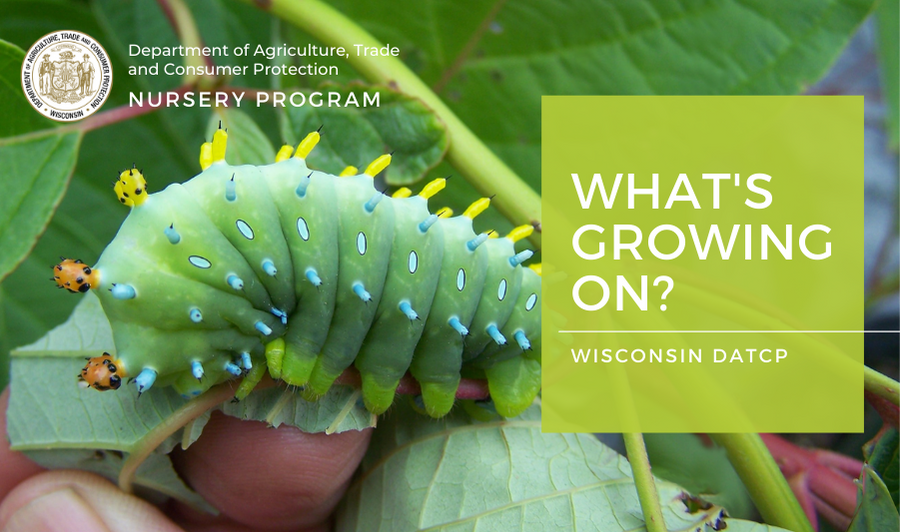 _____________________________________
Dear Wisconsin nurseries, Christmas tree growers, and gardeners:
Hopefully your holidays were relaxing and joyful. As fieldwork has slowed down for the moment, we're taking this month to recap some of our fieldwork efforts of 2023.
Please send any feedback, questions, or ideas for future e-news updates to datcpnursery@wisconsin.gov.
Having trouble viewing this email? View it as a Web page.
_____________________________________
|
|
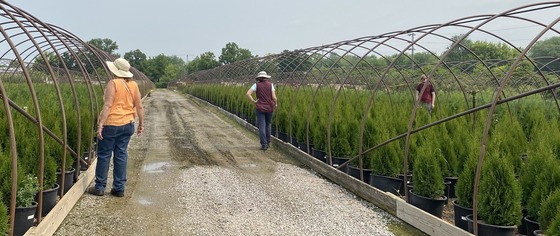 DATCP nursery inspectors team up to help inspect a large Wisconsin nursery | DATCP image
The Nursery Program licensed 645 nursery growers and 1,254 retailers in 2023, with staff inspecting 493 (55%) growing field locations and 452 (20%) retail locations statewide. Nursery inspections typically begin in mid-April and continue through September. Annual inspections are prioritized for out-of-state shippers and those holding a Plant Health Certificate (PHC). 117 PHCs were issued for the out-of-state movement of Wisconsin nursery stock.
The top 10 issues recorded during inspections and the number of observations include: spider mites (295), virus-like symptoms (191), assorted aphids (179), Japanese beetle (179), powdery mildews (151), deer browse/damage (86), assorted needlecasts (81), balsam twig aphid (80), unspecified leaf spot (68), and nonviable stock (68).
As Dec. 31st, 2023, the PIB lab processed 354 nursery samples (330 for pathology, 34 for entomology), 32 Christmas tree program samples (21 for pathology, 14 for entomology), 119 phytosanitary program samples (119 for pathology, 80 for entomology), 3 potato program sample, and 7 environmental enforcement program samples (7 for pathology, 2 for entomology) for plant pest and disease identification.
A total of 52 nursery-related compliance documents were issued in 2023. 37 incidents of NR40 plants were found at 29 unique nursery locations. 13 documents were issued to entities requiring a nursery license while the rest were for various infractions, including nonviable stock, mislabeling, and plants found with pests or pathogens of regulatory significance. To increase awareness and educate other states on Wisconsin plant regulations, staff sent out six Rejection Notices to four states (Iowa, Michigan, Ohio, and Oregon) for unwanted invasive plants, viruses, and scale insects.
_____________________________________
|
|
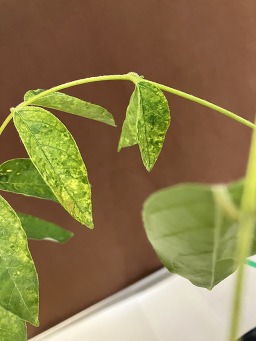 Leaf mottling caused by a potyvirus on Wisteria | DATCP E. Voigt
|
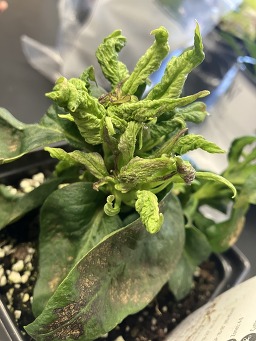 Leaf distortion caused by alfalfa mosaic virus on phlox | DATCP E. Voigt
|
|
|
Plant viruses continue to be a serious problem for nursery production. Besides lowering the commercial value and productivity of ornamental plants, many viruses can also be transmitted to agricultural crops. The Plant Industry Bureau (PIB) Laboratory, in cooperation with DATCP nursery inspectors, have conducted sampling and testing for viruses in Wisconsin nurseries and greenhouses for the last 20 years.
In 2023, Nursery inspectors collected 136 ornamental samples for virus testing at DATCP’s PIB Lab. Tobacco rattle virus (TRV) had the most detections at 62. TRV was detected in the following hosts: astilbe (24), bleeding heart (24), clematis (1), horseradish (1), hosta (4), joe-pye weed (1), lobelia (1), peony (4), phlox (1), and spiderwort (1). Potyviruses were detected on the following hosts: iris (3), rose (1), sedum (2), and wisteria (3) for a total of nine detections. Hosta virus X (HVX) was detected on nine hosta samples. Cucumber mosaic virus (CMV) was detected on astilbe (1), lobelia (1), and monkshood (1), for a total of three detections. Ilarviruses were detected on five occasions on the hosts astilbe (3), joy-pye weed (1), and sow thistle (1). Impatiens necrotic spot virus (INSV) was found once on a begonia. Alfalfa mosaic virus (AMV) was found once on phlox. Tomato ringspot virus was found once on a lily. Several plants co-infected with two viruses were observed: astilbe ‘Fanal’ with Ilarvirus and TRV (2), astilbe ‘Bridal Veil’ with Ilarvirus and TRV (1), joe-pye weed with Ilarvirus and TRV (1), and lobelia ‘Monet Moment’ with CMV and TRV (1).
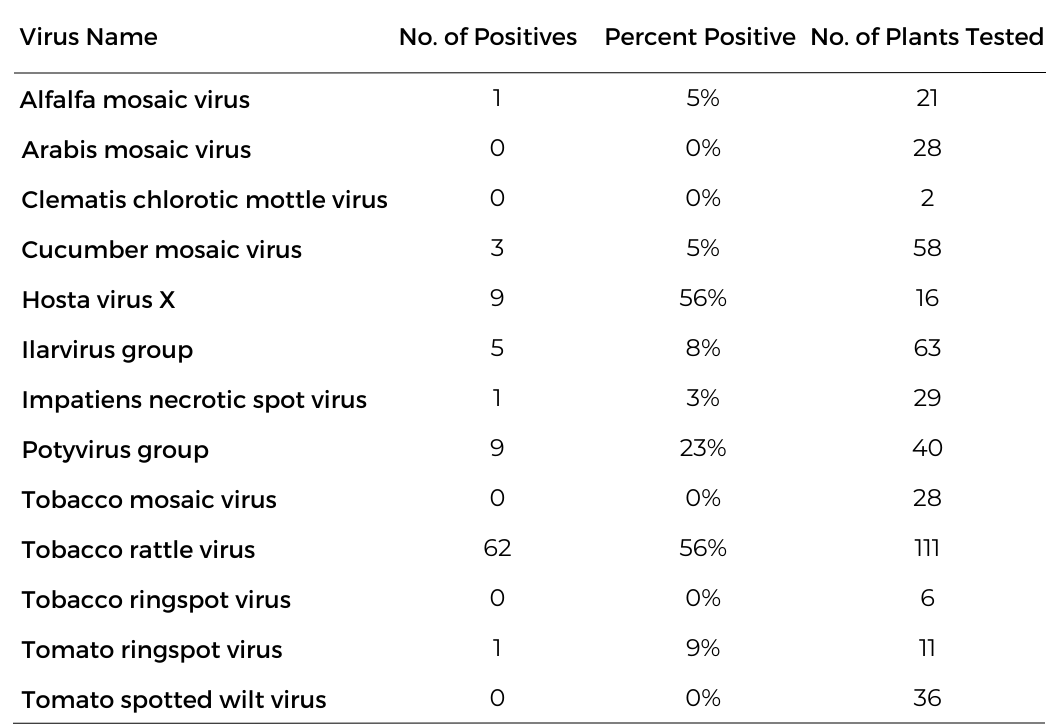 Table 1. Viruses on ornamentals diagnosed at the Plant Industry Laboratory in 2023 | DATCP image
|
|
|
Note that not all plants symptomatic for virus found during nursery inspections are submitted to the PIB lab for testing.
_____________________________________
|
|
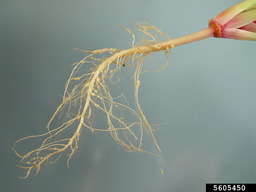 Root Knot Nematode galls on spinach | Gerald Holmes Strawberry Center, Cal Poly San Luis Obispo, Bugwood.org.
|
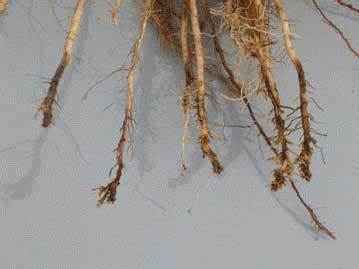 Root Lesion nematode damage on corn | Tamra Jackson-Ziems, University of Nebraska - Lincoln
|
|
|
In 2023, the PIB Lab conducted an ad hoc survey of ornamental nursery stock for root-knot (Meloidogyne sp.) and root lesion (Pratylenchus sp.) nematodes. These nematodes cause disease in hundreds of plant species worldwide. Symptoms of root-knot and root lesion nematodes can be difficult to recognize because the above-ground symptoms mirror those of general plant root stress. In addition, low nematode populations may not cause any noticeable above-ground plant symptoms.
Root-knot nematodes cause distinct galling (swelling) of infected roots. These galls form in response to feeding by the root-knot nematodes on the plant’s roots. Root lesion nematodes cause necrotic lesions to develop on the plant’s roots. As the nematode feeds and moves through the roots, the lesions may coalesce and girdle the roots, leading to a reduced root system.
The PIB Lab screened 94 samples for root-knot and root lesion nematodes; eight samples were positive for root-knot nematodes and six for root lesion nematodes. All plants found to be positive for root-knot nematodes were astilbes. The host plants affected by root lesion nematodes were astilbe (3), barrenwort, (2), and bleeding heart (1).
Soil-borne nematodes such as root-knot and root lesion nematodes may be spread by contaminated tools and soil, natural movement through the soil, and contaminated plant propagules. Although these nematodes may not cause immediate plant death, they reduce plant vigor and provide opportunities for other plant pathogens to invade infected plants. For these reasons, it is important to be aware of the symptoms, monitor for these pests, and not propagate from or offer for sale plants infected with nematodes.
_____________________________________
|
|
 Large Wisconsin Christmas tree field ready for inspection | DATCP T. Boyle
Inspectors started Christmas tree field inspections the beginning of September and transitioned to lot inspections in late November. During fall inspections, 544 (69%) fields were inspected for 234 of the 376 licensed Christmas tree growers. Spongy moth egg masses were found in, or around the perimeter of, 49 Christmas tree fields, an increase from the previous season of 23 fields with spongy moth egg masses.
From mid-November to the week before Christmas, 95 Christmas tree sales lots were inspected. Three locations had material with Elongate Hemlock Scale (EHS) and two locations had Balsam Woolly Adelgid infested material. Material with these regulated pests was ordered to be removed from sale and destroyed.
_____________________________________
|
|
|
DATCP had 725 licensed seed labelers in 2023. Our seed testing laboratory is contracted so we do not conduct sample testing in-house. Compliance sampling is targeted by sampling all labelers on a three-year rotation and focusing on problem seed, as well as labelers with compliance problems.
In 2023, 142 (20%) of licensed labelers were inspected and 90 (12%) were sampled, for a total of 371 samples. The overall violation percentage of 6.7% is the highest it’s been since 2013. There were six minor violations (one for purity and five for germination claims) and there were 19 serious violations (13 germination, one purity, four restricted noxious weed, and one for prohibited noxious weed seed). Nine seed lots in violation were relabeled, six lots were removed from sale by the labeler, three were returned to the labeler, one was ground for feed, and three lots are pending.
This season, there were also five samples taken where amaranth species were detected. These samples were all sent out for further identification, and none were found to be the Wisconsin prohibited species of Palmer amaranth or waterhemp.
_____________________________________
|
|
|
To ship Wisconsin plants or plant products internationally, a phytosanitary certificate is needed. Phytosanitary certificates are issued by the U.S or a state department of agriculture certifying to foreign governments that the products are free of pests and diseases. 577 certificates are used for raw or relatively unprocessed plants or plant products such as lumber, logs, nursery stock, grain, fruit, and more. 579 certificates are used for the same materials as the Federal Phytosanitary Certificate (PPQ 577) described above, but the materials have been imported into the U.S. and will be re-exported back out to a foreign country right away.
The table below shows certificate totals for January 1, 2023 through December 31, 2023.

_____________________________________
|
|
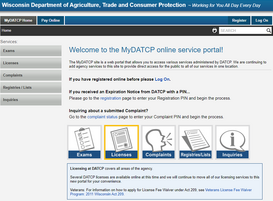
Nursery and Christmas tree licenses for this growing season (LY2024) will expire on February 20, 2024. Paper expiration notices to renew your license for the next growing season (LY2025) were mailed in late November. Expiration notices were emailed on December 4, 2023. Please contact us if you have not yet received one of these communications.
License renewals can be completed online using the MyDATCP portal. If you have never used the online license portal, a PIN will be located on your expiration notice so you can register for a MyDATCP account. If you need assistance getting into your account, contact datcpnursery@wisconsin.gov or (608) 224-4574.
Renewing online is an efficient way to update location information, contact information, and sources of plant materials without having to mail in a paper application. Also, once your license is issued, you have the ability to print your license certificate directly from your MyDATCP account - no need to wait for the mail.
If you are no longer in business, please let us know so we can close your license. This avoids any enforcement actions, which may occur for entities who fail to contact us or renew by the February 20, 2024 deadline.
Tips and Reminders:
- Allow pop-ups from MyDATCP.
- Only one tab of MyDATCP can be open at a time.
- If you have multiple license types, they each need to be renewed individually. However, you can pay for them all at once by accessing your invoices from the "My Invoices" tab of MyDATCP.
- Watch the short video tutorial to walk you through the online renewal process.
- Renew your nursery license before Feb. 20 to avoid the 20% late fee, and to check this off your busy to-do list!
For more information, email DATCPnursery@wi.gov, call (608) 224-4574, or visit the Nursery and Christmas tree licensing webpage.
|
_____________________________________
|
|
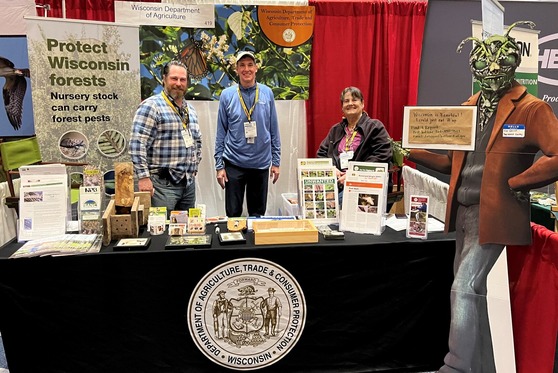 DATCP booth at the 2023 iLandscape Show | DATCP image
DATCP's Plant Protection staff will be exhibiting at some upcoming events. Stop by to visit with us, ask questions, share your insights and suggestions, and learn about the latest plant pest and diseases, pollinator protection, certified firewood, and more.
_____________________________________
|
|
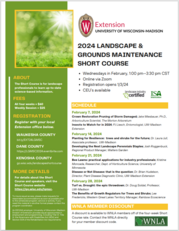
The Landscape and Grounds Maintenance Short Course, put on by UW-Extension and sponsored in part by the Wisconsin Nursery and Landscape Association (WNLA), is for landscape professionals to learn up-to-date, science-based information to help you increase the economic and environmental sustainability of landscapes you care for and your business.
February 7, 14, 21, & 28 – 2024
1:00 - 3:30 p.m. on Zoom
|
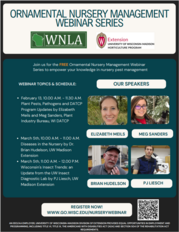
The Ornamental Nursery Management Webinar Series is being put on by UW-Extension and the WNLA. This free series is for the green industry to learn about pests and diseases to be on the lookout for, as well as pest and disease trends in Wisconsin.
February 13 and March 5, 2024
10:00 - 12:00 p.m. on Zoom
|

Create a Beautiful Landscape Free of Invasive Plants Webinar. Horticulturist, author, and speaker Melinda Myers will discuss key invasive plants in Wisconsin, share tips on identification, provide ways to control some of the more common problem plants, and suggest alternative plants for your landscape in this free webinar.
February 28, 2024, 6:30 p.m. on Zoom
|
_____________________________________
|
|
|
|
|